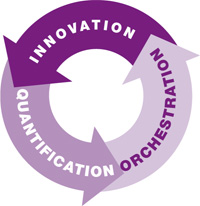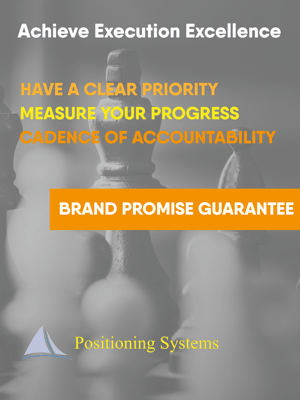 One of my customers, who had been my E-Myth Customer, now a ScaleUp customer, reminded me of the importance of Innovation, Quantification, Orchestration.
One of my customers, who had been my E-Myth Customer, now a ScaleUp customer, reminded me of the importance of Innovation, Quantification, Orchestration.
Last Thursday I made a presentation to his leadership team on Michael Gerber’s principles of Innovation, Quantification and Orchestration.
If you’ve read the E-Myth Revisited you understand the power of his message for small businesses, and the impact systems have for growing a business. Mid-size as well as Fortune 500 size businesses sometimes lose track of these fundamentals. It’s important for you and your team to be mindful of these are you continue to grow.
Here’s a brief review of these principles, with a note of caution on Gerber’s principle of innovation.
Gerber’s Innovation didn’t foresee Digital Disruption, Gerber’s Innovation is more focused on innovating present systems.
Michael Gerber, in the E-Myth Revisited defines Innovation as:
“It is the skill developed within your business and your people of constantly asking, ‘What is the best way to do this?’ knowing, even as the question is asked, that we will never discover the best way, but by asking we will assuredly discover a way that is better than the one we know now?”
As we wrote in Are Best Practices Dead?, Innovation today is often a startup moving to a whole new platform or way of conducting business to disrupt the present industry. Digital photos eliminated Kodak. Uber virtually eliminated taxis. In his article, Best Practices are Dead, Tom Puthiyamadam outlines how digital transformation is eliminating the reliance of best practices as a viable strategy for improvement.
Let’s review these three practices of Innovation, Quantification, Orchestration with some quotes by Michael Gerber to add context for each:
Innovation
“Creativity thinks up new things. Innovation does new things.” - Theodore Levitt, Harvard Business School
Innovation is about creating new systems, enhancing existing systems. It’s doing things in a better way.
The Systems Innovation Process
A system consists of a series of steps, or "benchmarks" that work together within the system to produce a desired result.
- Step one is to select a system that you would like to improve
- Step two is to observe exactly how that system is currently operating
- Step three is to move beyond observation and to diagram how effectively the current system is, or is not, working
- Step four is to quantify and measure input/output costs, which will be the baseline against how you will measure future performance
- Step five is to analyze the system's workflow to improve or change whatever systems aren't working, or aren't producing the needed results
- Step six is to implement new techniques for improving the workflow. This will necessitate redrafting the current system to encompass the new changes
- Step seven is to quantify the newly revised system
At the end of this process, your newly "innovated" system doesn't exceed the performance of the "old" system, go back through the steps again. Keep cycling through the steps until you develop an innovated system that improves performance.
Quantification
 “You can’t manage what you don’t measure, and what you don’t measure you don’t understand.”
“You can’t manage what you don’t measure, and what you don’t measure you don’t understand.”
-Michael Gerber, E-Myth Revisited
Quantification is the objective evaluation of business performance. Quantified information prevents micromanagement. Know the right measurements for each system. Monitor these to ensure your systems operate effectively.
Key Performance Indicators
You need Key Performance Indicators to tell you me how your system is performing. Quantification is three levels: strategic, business, and systems indicators.
- Strategic indicators give you a sense of the general health of your business. They are of the highest form, usually designed around the objectives or long-term goals you have for your business. Annual revenues, profits, growth rates, and market share are all examples of strategic indicators.
- Business indicators quantify the different functions in your organization. Examples include leads per day, percentage of leads converted to sales, average sale, NPS Scores, Customer complaints.
- Systems indicators measure performance of specific systems in your business.
Systems like Metronome Growth Systems allow my customers to monitor these at each level of the business.
The Business Quantification Process
- Step one is to identify the business activities and results to be quantified.
- Step two is to establish your management report structure.
- Step three is to use or create a system for collecting the necessary data.
- Step four is to design the management report.
- Step five involves use or creating systems for producing the management report.
- Step six is to refine and upgrade the report on a regular basis.
The Discipline of Quantification
Most of this is rudimentary for a mid-sized business. Yet I know businesses on a large scale that fail to do this. It’s fundamental and must not be neglected.
Orchestration
"The need for Orchestration is based on the absolutely quantifiable certainty that people will do only one thing predictably - be unpredictable."
~ Michael Gerber, E-Myth Revisited
Orchestration commits to your customers and employees "this is the way we do it here." Orchestration is about producing consistent, predictable results through your proprietary way of doing business. It’s develops Your DIFFERENTIATION.
There are multiple ways to win, as we explained in Strategy – How to Win? There are two choices, Low Cost or Differentiating. Only the true low-cost player can win with a low-cost strategy.” A.G. Lafley, Playing to Win: How Strategy Really Works.
The process of Orchestration defines your differentiation.
The Orchestration Process
Orchestration engages your organization in what’s discovered through your innovation and quantification processes. Here’s the E-Myth’s simple step-by-step system for how a leader can orchestrate any system.
- Step one is to implement and change any documentation that uses the newly innovated system.
- Step two is to distribute the new system to all that are applicable.
- Step three is to train all employees who engage with the system.
- Step four is to hold people accountable to using the newly innovated system.
- Step five is to analyze the system’s results to ensure that what’s needed is intentionally being created.
- Step six is to re-start the business development process all over again, as deemed appropriate.
The biggest frustration/issue is, as circumstances change; systems need to change. Your business/system development process is not stagnant; it’s ongoing.
Growth demands Strategic Discipline.
 How can you build an enduring great organization?
How can you build an enduring great organization?
You need disciplined people, engaged in disciplined thought, to take disciplined action, to produce superior results, to make a distinctive impact in the world.
Discipline sustains momentum, over a long period of time, to lay the foundations for lasting endurance.
It’s the framework for Good to Great:
- Stage 1: Disciplined People
- Stage 2: Disciplined Thought
- Stage 3: Disciplined Action
- Stage 4: Build Greatness
A winning habit starts with 3 Strategic Disciplines: Priority, Metrics and Meeting Rhythms. -2.jpg?width=300&name=3%20Disciplines%20of%20Execution%20(Strategic%20Discipline)-2.jpg) Forecasting, accountability, individual, and team performance improve dramatically.
Forecasting, accountability, individual, and team performance improve dramatically.
Meeting Rhythms achieve a disciplined focus on performance metrics to drive growth.
Positioning Systems helps your business achieve these outcomes on the Four most Important Decisions your business faces:
|
DECISION |
RESULT/OUTCOME |
|
PEOPLE |
|
|
STRATEGY |
|
|
EXECUTION |
|
|
CASH |
|
Positioning Systems helps mid-sized ($5M - $250M) business Scale-UP. We align your business to focus on Your One Thing! Contact dwick@positioningsystems.com to Scale Up your business! Take our Four Decisions Needs Assessment to discover how your business measures against other Scaled Up companies. We’ll contact you.
 Next Blog – Strategies For Getting Better Sleep
Next Blog – Strategies For Getting Better Sleep
Adequate sleep is a major impact on engagement and effectiveness at work, particularly for an owner or CEO. 24% of people surveyed report insufficient sleep makes them less productive at work, and 13% report making more mistakes. We’ll explore getting more sleep with our guest blogger Karoline Gore providing the ideas to help you sleep better, next blog.






.jpeg?width=150&height=135&name=Hand%20with%20marker%20writing%20the%20question%20Whats%20Next_%20(1).jpeg)

